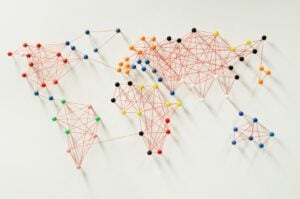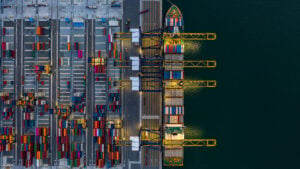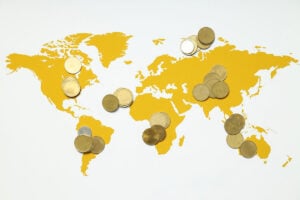The multiplying, intensifying disruptions occurring in several of the most critical regions of the world, from the Middle East to southeastern Europe, with East Asia increasingly in the balance, is roiling the strategic planning of corporate executives and investment managers, especially in national and global energy markets. In these first weeks of 2024, there is little reason to anticipate a diminution of these international security disruptions, as America’s archrivals and lesser adversaries increasingly perceive its deterrence capabilities as weakened and therefore less credible.
Yet even with the current Middle East crisis fomented by Iran’s 40-year-long war against the U.S., Israel and their regional Sunni Arab allies, international security strategists must focus primarily on the long-term competition between the United States and China. The People’s Republic of China is the world’s second largest economy with the world’s fastest growing military led by a repressive techno-authoritarian Communist Party apparatus that seeks to upend and in many ways overturn and replace American global leadership through a system of rival national blocs and market systems.
In addition, the potential outcomes of the Russian invasion of Ukraine, soon to enter its third year and with little imminent prospect of a ceasefire or settlement process, will in turn influence American and European decisions regarding the viability of long-term funding for Ukraine’s reconstruction. East Asia has become more tense in recent months with Pyongyang’s resumption of intimidating missile tests that rattle Japanese and South Korean markets, adding extra volatility in a region already fearful of growing Chinese threats against Taiwan. In conjunction with Iran, North Korea has been shipping more than a thousand containers of armaments to Russia to replenish its arsenal against Ukraine.
However, the barbarous pre-civilizational Oct. 7 massacres of 1,400 Israeli civilians and 39 Americans by the Iranian-funded, Iranian-armed and Iranian-trained proxy terror group Hamas has significantly shifted global security dynamics. The escalated destabilization of the Middle East by the radical theocratic regime that is the Islamic Republic of Iran is the necessary start to bracing for 2024.
ROOTS OF THE CURRENT CONFLICT
The U.S. Department of State has classified the Iranian regime since 1984 as the world’s leading state sponsor of international terrorism and did so again in its most recent report in October. Since the 1979 revolution, Tehran has sought to establish regional dominance by launching proxy militias and terror organizations in Iraq, Syria, Lebanon, Bahrain, Yemen and, of course, Gaza after Israel withdrew completely from the area in 2005.
Tehran deems Israel an unacceptable political presence in the region and has publicly proclaimed its intention to eventually destroy the country. It also considers Saudi Arabia its greatest rival for Islamic leadership given the two countries’ respective identities as leaders of the Shia and Sunni traditions within the Islamic faith. Therefore, Tehran viewed the potential normalization of diplomatic relations between Israel and Saudi Arabia, and U.S. support for a prospective Saudi nuclear energy program, as a mortal threat to its regional dominance ambitions. Riyadh has suspended those negotiations with Jerusalem pending the outcome of the military campaign against Hamas, and potentially against Hezbollah, but is likely to remain committed to Israeli diplomatic normalization over the long term.
Hamas feared that an Israeli-Saudi agreement would include a new governing structure for Gaza comprised of Saudi Arabia, Egypt and other Sunni Arab governments replacing the terror group that has run Gaza dictatorially since ousting the Palestinian Authority in 2007.
In one of his last interviews before his death, Henry Kissinger advised that the West Bank be placed under Jordanian control, given that any serious prospect for a so-called “two-state solution” was extinguished by Hamas’ invasion of southern Israel.
The post-invasion environment in Washington and many European capitals willfully pretended that Iran’s continued leadership role in all such attacks against Israel did not apply to this most catastrophic assault. However, Hamas would not have conducted such confrontational massacres against Israel, especially given the sure overwhelming military response, without Tehran’s prior approval.
The dilemma now for Washington is to support the Israeli Defense Forces’ planned operations to eliminate Hamas as the governing authority in Gaza within a kinetic environment where Arab neighbors protest Palestinian civilian casualties. Tehran seeks to rupture relations between Israel and the six Arab countries with which it enjoys diplomatic relations, including under the September 2020 Abraham Accords.
POTENTIAL EXPANSION
The war against Hamas may expand regionwide if the Iranian-funded, Iranian-armed and Iranian-trained Hezbollah terror organization launches more lethal attacks against Israel from its arsenal of 200,000 rockets, many of which have been transformed into precision missiles thanks to the technical support of the Iranian Revolutionary Guard Corps, the primary extraterritorial branch of the Iranian Armed Forces.
According to the State Department’s October 2023 terrorism report: “Iran used the Islamic Revolutionary Guard Corps-Qods Force (IRGC-QF) to provide support to terrorist organizations, provide cover for associated covert operations, and create instability in the region. The IRGC-QF is Iran’s primary mechanism for cultivating and supporting terrorist activity abroad. … Iran also used regional militant and proxy groups to provide deniability, in an attempt to shield it from accountability for its destabilizing policies.”
Hamas officials publicly boast about their Iranian links, and Hezbollah leader Hassan Nasrallah said in 2016 that “Hezbollah’s budget, everything it eats and drinks, its weapons and rockets, comes from the Islamic Republic of Iran.” The State Department estimates Iran sends about $100 million annually to Hamas and to Islamic jihad in Gaza and about $700 million a year to Hezbollah.
Immediately after the massacres, the Biden administration deployed one aircraft carrier fleet into the eastern Mediterranean to deter Hezbollah and a second aircraft carrier fleet to the Arabian Sea and perhaps into the Persian Gulf to more directly confront and deter Iran from expanding the war.
As a result, coordinated attacks with Hezbollah against northern Israeli targets would be unsurprising and likely just a matter of time, especially if Tehran feels undeterred by Washington’s regional military posture. Israeli retaliatory attacks against Hezbollah could lead Iran to open another front from its militia bases inside Syria and Iraq. Israeli military sources estimate that Iran operates about 50 bases in Syria alone, and the Israeli military has been conducting a covert bombing campaign against these proxy bases as well as Syria’s major airports used to ship Iranian weaponry. Iran could also direct the Houthi rebels it backs against the Yemeni government to assault Israeli shipping in the Red Sea and through the narrow Bab el-Mandeb Strait.
RUSSIA, CHINA CONSIDERATIONS
Washington’s deterrence strategy against Iran will also have to consider Chinese and Russian interests in the Middle East. Russia has an air base and a naval base in Syria, and its military has defended and propped Bashar al-Assad’s regime in Damascus for nearly a decade. China secures 40% of its oil imports from Iran, despite the U.S. oil sanctions, and another 15% from Saudi Arabia. Any war-related disruptions of shipping through the Strait of Hormuz would be of significant and unacceptable economic consequence to Beijing as well as to America’s Asian allies and partners, including Japan, South Korea and Taiwan.
To a lesser yet still significant degree, commercial disruptions through Egypt’s Suez Canal or the Bab el-Mandeb Strait at the southern mouth of the Red Sea could further disrupt global energy supply chains.
China’s commercial and diplomatic influence in Tehran and Riyadh led to the measured rapprochement Beijing announced between Iran and Saudi Arabia in March 2023. Beijing has further exploited the current regional crisis to accuse the U.S. of decades of failed diplomatic and military leadership. Fragile Middle Eastern diplomacy is further impacted by the extent to which China, Russia and Iran together seek to foment regional and wider instability to whittle away at America’s modern leadership position as a zero-sum calculation, regardless of the impact on tens or hundreds of thousands of civilian lives within the affected countries.
CHALLENGE TO US GLOBAL POWER
Iranian-directed operations that continue to engage Israeli Defense Forces throughout 2024 could affect the U.S. presidential contest in November. Leading candidates will debate how best to restore American hard power and deterrent capability given the chaotic withdrawal from Afghanistan, the failure to deter Russia’s re-invasion of Ukraine or repeated Iranian proxy attacks on U.S. bases and forces, and now the failure to detect or prevent Hamas’ invasion of southern Israel.
American global power is being challenged not just militarily and diplomatically, but also financially. The loose BRICS network, comprised of Brazil, Russia, India, China and South Africa, recently welcome Argentina, Egypt, Ethiopia, Iran, Saudi Arabia and the United Arab Emirates into their fold. These countries seek not to compete against or eventually topple the global primacy of the G7 bloc, but, more likely, they are pursuing a broader series of options to denominate their trade transactions given the speed and force with which the Biden administration led their wealthiest allies and partners to join the sanctions regime against Russia.
The BRICS members will ramp up their trade in their own currencies, rather than rely on the dollar’s continued status as the world’s leading currency exchange reserve. There is no serious challenge to the dollar for the near future. As the International Monetary Fund noted in early 2023, “The absence of alternatives to the safety of dollar-trade invoicing, international funding markets, and the large supply of guaranteed Treasury bonds suggests that the dollar’s role in the global economy is secure.”
RISE OF THE GLOBAL SOUTH
Parallel to the expansion of the BRICS network is the rise of the so-called Global South countries. The description applies essentially to the large number of developing countries and emerging markets that possess significant natural resources, especially rare earth elements and critical metals essential to the technology-based global economy. Many of these countries view the Ukraine invasion as an intra-European or even an intra-Slavic problem, esoteric and with little impact on their national security or societal well-being. They value their commercial relations with Russia, especially for oil, gas and coal, as well as for foodstuffs and fertilizers essential to feed their citizens and grow their agricultural export sectors.
Of further interest is the sheer number of countries in play. Depending on whether the Global South includes large economies such as those of China and India, or smaller yet wealthy Gulf states, the grouping comprises about 130 countries. The United Nations consists of mostly nondemocratic member nations but operates largely on a one-member one-vote basis. The dictatorial Chinese Communist Party has been especially successful at exploiting this democratic governance of the U.N. and its many subsidiary international organizations.
Working through China’s trillion-dollar Belt and Road Initiative to build major infrastructure projects by exporting excess national industrial and labor capacity to more than 140 countries, Beijing exerts influence if not outright pressure on recipient countries to vote in international bodies with China, or to prevent passage of resolutions and punitive measures criticizing China’s international law violations, environmental degradation and human rights abuses. The influence of the Global South, even at an uncoordinated level, has also been apparent in the unwillingness of most of those countries to support U.S. and EU sanctions on Russia.
UKRAINE FUNDING ISSUES
Ukraine’s challenges are compounded by the gruesome reality of the battlefield. As far back as July, American artillery shells were in such short supply that the Biden administration opted to provide Ukraine with controversial cluster bombs that are banned in more than 100 countries due to the immediate and long-term civilian harm of unexploded remnants that act as landmines for years. At an October White House press briefing, National Security Council spokesman Admiral John Kirby stated that “on Ukraine funding, we’re coming near to the end of the rope. We’ll keep that aid going as long as we can, but it’s not going to be indefinite.”
In November, NATO’s most senior military official informed a European security conference regarding the alliance’s ammunition stockpile to continue supporting Ukraine that “the bottom of the barrel is now visible.” Shortly thereafter, CIA Director William Burns met in Kyiv with Ukrainian President Volodymyr Zelenskyy, and German media reports later described a March 2023 agreement between President Joe Biden and Chancellor Olaf Scholz to persuade Ukraine into peace talks with Russia by mid-2024.
Zelenskyy publicly opposes any such negotiation, instead insisting that all Russian forces leave Ukraine and that Russian “war criminals” be brought to trial. NATO does not have available military inventory, the financial or industrial means to jump-start a wartime production capacity, or the political will to achieve Zelenskyy’s understandable if overly ambitious objectives.
Kyiv’s ability to sustain the level of American political support after two years of mostly inconclusive combat against 600 miles of multilayered, in-depth and nearly impenetrable Russian strategic defense lines will be challenging.
If the Middle East crisis continues to sap U.S. and European military and diplomatic resources, financing and leverage, Ukraine may be on a path in 2024 toward military failure and potential state collapse. Washington and Brussels may attempt to embark on the long-term reconstruction of Ukraine, a decadeslong project that will cost as much as $1 trillion.
At the same time, China has been one of the greatest beneficiaries of the Ukraine invasion. It has been purchasing massive quantities of oil and natural gas, the former at discounted prices. It has expanded its export penetration of Russian markets as Western sanctions have choked off many previous commercial channels. Moscow’s diplomatic and financial isolation in the West has rendered it more dependent on Beijing, a source of considerable Russian discomfort given the centuries-old enmity between the two largest powers in Eurasia.
The invasion has also rattled the decades-old system of nuclear weapons agreements between the U.S. and Russia. The Kremlin announced that Washington is proposing to resume negotiations on expired and expiring nuclear weapons limitation agreements in a process compartmentalized from the Ukraine war and its attendant consequences. Moscow considers such negotiations nearly impossible without a change in what it considers the “deeply fundamental hostile course towards Russia on the part of the U.S.” The U.S. and Russia will soon enter the first period in a half century with no arms control agreements in place, even as China increases its nuclear warhead arsenal from about 500 currently to 1,000 by 2030 and a planned 1,500 by 2035.
Democrats and Republican have begun debating how best to enhance American military power and deterrence capability to adapt to an international security environment with two nuclear-armed superpowers and also to prevent secondary crises and conflicts. The Congressional debate is complicated by federal debt interest payments that now exceed the U.S. defense budget and are projected to surpass $1 trillion annually by 2028.
CRIPPLING ENERGY POLICIES
One of the most destructive consequences of the Ukraine invasion is the impact on neighboring European economies. Among the most critical reasons for Europe’s inability to sustain support for Ukraine is Germany’s crippling energy policies of the past decade.
After tsunami waves caused an accident in 2011 at Japan’s Fukushima nuclear reactor, Berlin opted to close all its nuclear plants, embrace a radical decarbonization strategy and shift rapidly toward alternative energy production such as solar and wind. In the wake of the Russian invasion of Ukraine, Germany is scrambling to build LNG refineries to import supplies mostly from the U.S. and Qatar, which retain excess production capacity. In London, hydraulic fracturing for shale gas was banned in 2019 and reinstated in September 2022 due to the shock inflation of British energy prices resulting from soaring European energy prices after the invasion of Ukraine.
Skyrocketing spot energy prices, especially for natural gas after the cutoff of Russian supplies, has initiated the slow deindustrialization of Germany and potentially the United Kingdom. German and British voters may decide that unaffordable energy, high taxes and the social costs of rigid climate policies and open illegal migration compel a re-prioritization of Berlin’s and London’s assistance away from Ukraine and back into domestic priorities and the wider European bloc. Given the stunning Netherlands elections result this past November, similar anti-establishment sentiments may play out all year across Europe, where at least seven presidential elections and nine parliamentary elections will take place through December.
HOSTILE ENERGY SUPPLIER
Just as Germany, the U.K. and other European countries became willfully dependent, by their own decisions, on a hostile authoritarian supplier of energy, so too do some political leaders in the industrial West seem destined to forego “all of the above” energy supplies for a more robust and secure strategy and instead become dependent on another hostile authoritarian supplier of energy to power the economies in the decades ahead.
Beijing’s “Made in China 2025” program to dominate the leading breakthrough technologies of the 21st century includes battery electric vehicles, solar panels and wind turbines. Chinese Communist leaders saw the opportunity in the early 2000s to exploit the growing impulse in Western capitals to abandon reliable, affordable and readily available coal, oil and natural gas and to instead pursue intermittent, weather-dependent alternative energy production as a replacement for hydrocarbons. China has come to dominate the global production of these three alternative energy sectors of growing importance in the U.S. and EU, due mostly to massive distortional government subsidies of their mandated installation and consumption.
China utterly dominates the global supply chains for electric vehicles and will do so for the foreseeable future. The Communist Party is targeting Germany’s global automotive industrial lead just as it successfully collapsed Germany’s and Europe’s solar panel manufacturing advantages in the late 2000s and early 2010s. Those industries are now flattened in Europe, and China controls most of the refining and processing of rare earth elements required to build solar panels, wind turbines and all-electric vehicles as well as their batteries that Americans are being subsidized to purchase under the Inflation Reduction Act’s $400 billion loan program designated for alternative energy. Last March, Goldman Sachs analysts predicted that the actual taxpayer outlays under the alternative energy program would exceed $1.2 trillion.
Ironically, solar panels, wind turbines and electric vehicle batteries cannot be built without the energy-intensive production of steel and cement that require coal, oil and natural gas. As Beijing tightens its grip on the manufacturing of these alternative energy components, it is the world leader in coal plant expansion and is planning as many as 300 new coal projects at an equivalent rate of two coal power plants being permitted every week, each one designed to last 40 years.
THE BIG QUESTION
Thus we confront a critical “grand strategy” question of our day: Why is the West seemingly and illogically sleepwalking into alternative energy dependence on the Communist Party of China that is determined to supplant America’s global economic and military dominance, especially when the U.S. has been transformed by the pioneering extraction techniques of horizontal drilling and hydraulic fracturing to become an oil and gas exporting superpower?
In March 2023, Xi Jinping traveled to Moscow to consolidate China’s “no-limitation” strategic partnership with Russia. As he departed, Xi turned to his host Vladimir Putin before a massive global media entourage and stated, “Mr. President, right now there are changes, the likes of which we have not seen for 100 years, and we are the ones driving these changes together.” Putin responded, “I agree.”
The consequences for the United States, its worldwide allies and partners, and the international economic trading system are at stake. Throughout the West, democratic elections will serve as the bellwether for the near-term direction of civic responses to the radical changes sweeping the world in just the past two years. Energy geopolitics will matter less in the U.S. because our vast domestic hydrocarbon supplies provide our nation with essential resilience.
European politicians may be severely buffeted in 2024 by voter shifts that reflect everyday retaliation against poorly crafted energy dependence and open migration policies. Potential conflicts between Azerbaijan and Armenia, Serbia and Kosovo, or Morocco and Algeria, which has become one of Europe’s most important natural gas suppliers, could further rock European politics in 2024.
In Washington, foreign policy will be one of the most important voter considerations in four decades — since the Cold War. Several priorities can be expected to stand out. After the $113 billion in U.S. support for Ukraine, American voters will insist that American allies shoulder more of the burden for their own national and regional defense, in Europe and in Asia.
Countries investing in national defense, such as India, Israel and Poland, will see their U.S. relations enhanced. Washington will lean on energy importing countries such as Germany and Taiwan to take their own national security more seriously, to reallocate federal budgets to prioritize military preparedness and bolster regional deterrence, and to diversify their energy supplies more realistically amid the most significant international security upheavals of this still young century.
ABOUT THE AUTHOR
John Sitilides is a geopolitical strategist at Trilogy Advisors in Washington, D.C., a Senior Fellow for National Security at the Foreign Policy Research Institute, and a diplomacy consultant to the U.S. Department of State under government contract since 2006. He holds a master’s degree in international and public affairs from Columbia University.





